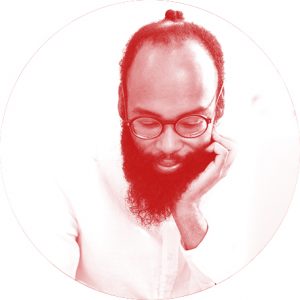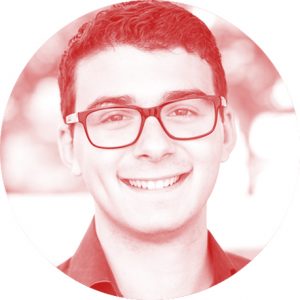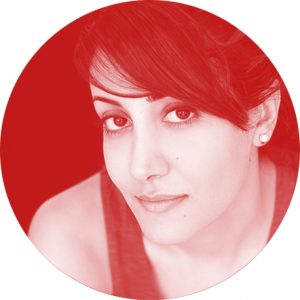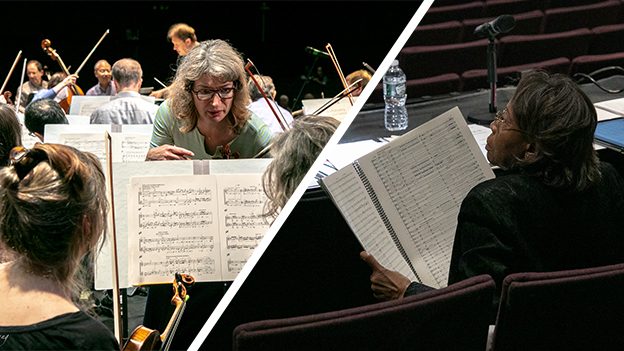Marian Anderson Theater
Aaron Davis Hall at The City College of New York
129 Convent Avenue at West 135th Street
New York, NY 10031
CORONAVIRUS UPDATES: ACO can no longer welcome a public audience to the Underwood Readings on March 12th and 13th. Amidst concerns of the spread of COVID-19, we are honoring the request of our venue, City College of New York, to restrict this event to ACO’s musicians, participating composers and staff. Read President Ed Yim’s full statement.
Read the 2020 Underwood Readings Program Book by clicking here.
| ABOUT
ACO will hold its 29th Annual Underwood New Music Readings for emerging composers on Thursday and Friday, March 12 and 13, 2020. Six composers will hear ACO perform their work live for the first time, receive personalized mentorship, and an archival recording. The Underwood Commission, a $15,000 commission for a new work for ACO, will be awarded to one of this year’s participants who include the following: Dai Wei, Saṃsāric Dance |
TICKETS *Please note: the following events are now closed to the public.* Open Rehearsal Public Run-Through Professional Development Panels |
SELECTED COMPOSERS
Dai Wei (Guangdong, China)

Dai Wei (she/her) is originally from China. Her musical journey navigates in the spaces between east and west, classical and pop, electronic and acoustic, innovation and tradition. She often draws from eastern philosophy and aesthetics to create works with contemporary resonance, and reflect an introspection on how these multidimensional conflict and tension can create and inhabit worlds of their own. Her artistry is nourished by the Asian and Chinese Ethnic culture in many different ways. Being an experi-mental vocalist, she performs herself as a Khoomei throat singer in her recent compositions, through which are filtered by different experiences and background as a calling that transcends genres, races, and labels. She recently served as Young Artist Composer-in-Residence at Music from Angel Fire and Composer Fellow at Intimacy of Creativity in Hong Kong. She has received commissions and collaborations with Utah Symphony Orchestra, Chamber Orchestra of Philadelphia, Bang on a Can, Curtis 20/21 Ensem-ble, Merz Trio, and the Rock School of Ballet in Philadelphia.
Her compositions were broadcast by WHYY, Performance Today, Radio Television Hong Kong, and Qinghai Television. Wei is currently pursuing a doctorate in composition at Princeton University as a Naumburg Doctoral Fellow. She is working on a piece called Partial Men for string quartet, live electronics, and voice where she will perform with Aizuri String Quartet. The piece is dedicating to two deceased men who donated their kidneys to her mother, and to many other deceased organ donors who extended other people’s life. Photo Credit: Cristina Cutt
About Saṃsāric Dance The successive existences in a series of rebirths are not like the pearls in a pearl necklace, held together by a string, the “soul,” which passes through all the pearls; rather they are like dice piled one on top of the other. Each die is separate, but it supports the one above it, with which it is functionally connected. Between the dice there is no identity, but conditionality. The title came from the Sanskrit word Samsara, which is often defined as the endless cycle of birth, death, and rebirth. In this piece, you will hear three different characters that represent three different lifetimes. They are being reincarnated and intersected by each other and more. It’s like a musical hotpot filled with diverse ingredients, and diversity is something we have since day one in our history. At the end of the piece, the orchestra evolves into only one pitch which represents the oneness of everything. As if we can finally rest. And yet, another journey is just about to start.
Anthony R. Green (Providence, RI)

The creative output of composer, performer, and social justice worker Anthony R. Green (he/him) includes musical and visual creations, interpretations of original, contemporary, and repertoire works, collaborations, educational outreach, and more. Behind all his artistic endeavors are the ideals of equality and freedom. His work has been presented in 20+ countries by Amanda DeBoer Bartlett, Eunmi Ko, the McCormick Percussion Group, Boston Landmarks Orchestra, counter)induction, Tenth Intervention, NOISE-BRIDGE, Access Contemporary Music, the Playground Ensemble, Ossia New Music Ensemble, and Alarm Will Sound, to name a few. His work has been presented at the ACA festival, the Grachten Festival (Amsterdam), Gaudeamus Muziekweek (Utrecht), Fulcrum Point New Music Discoveries (Chicago), and Ft. Worth Opera Frontiers (Texas), amongst others. A McKnight Visiting Composer, he has received support from numerous foundations and residencies in the US and Europe, including Kimmel Harding Nelson, VCCA, VICC (Sweden), Space/Time (Scotland), atelier:performance (Germany), and the Bemis Center for Contemporary Art.
As a performer, he has appeared at venues across the US, Europe, Asia, and the Middle East, presenting piano and chamber music recitals, interdisciplinary and experimental performances, and lecture-recitals that fuse performance with research. Green’s most important social justice work has been with Castle of our Skins, celebrating Black artistry through music. Photo Credit: Colin Conces
About Peace Till We Meet Again
Paul Novak (Reno, NV)

Paul Novak (he/him) writes music that is lyrical but fragmented, exploring the subtleties of instrumental color and drawing influence from literature, art, and poetry. He has received numerous national awards, most recently from the ASCAP/SCI Commission, Tribeca New Music, Webster University, and YoungArts Foundation, and has participated in festivals across the country, including the first-ever National Youth Orchestra of the United States Composer Apprenticeship. Novak has collaborated with ensembles including the Austin Symphony, Orlando Symphony, Reno Philharmonic, NYO-USA, the Amaranth and Rosco Quartets, Sō Percussion, Texas New Music Ensemble, NODUS Ensemble, MotoContrario Ensemble, Ensemble Ibis, Blackbox Collective, Face the Music, and Worcester Chamber Music Society; he has worked on interdisciplinary projects with Rice Dance Theatre, poets Ming Li Wu and Erica Cheung, and the Bowdoin Museum. Originally from Reno, NV, Novak is an undergraduate student at Rice University’s Shepherd School of Music, where he has studied with Kurt Stallman, Pierre Jalbert, Anthony Brandt, and Karim Al-Zand. Upcoming projects in Spring 2020 include a commission from the Texas New Music Ensemble, a soprano/contrabass duo for LIGAMENT, and work for viola and ensemble for violist Sebastian Stefanovic.
About as the light begins to drift
Christian Quiñones (Camuy, Puerto Rico)

Christian Quiñones (he/him) is a Puerto Rican composer whose music explores concepts like cultural identity and minorities within society, literature, and poetry. He was the 1st prize winner of the 2019 Boston New Music Initiative Young Composer Competition and the Pro Arte 2015 Composition Competition. His music has been performed by the Trio Sanromá, Victory Players, Cuban virtuoso René Izquierdo, Boston New Music Initiative, Orquesta del Conservatorio de Música de Puerto Rico, Young Artist Concert Orchestra (YACO), emerging talents such as Daniela Santos Colón. Christian has also been commissioned by The Association of professional dancers (APRODANZA), Young Artist Concert Series, and The Zodiac Festival in France where he was awarded the Distinguished Composer award. From 2018 to 2019 he was the composer in residence for the Mt. Holyoke MIFA Festival where he was commissioned by the Victory Players and worked on outreach programs bringing new music talks and performances to public schools in Massachusetts. Apart from his work as a composer, Christian has done research on the commissions of “Ballets de San Juan” to Puerto Rican composers, and an analysis of the sustainability of independent music in Puerto Rico during an economic crisis published by Musiké.
He obtained his BM in Music Composition at the Conservatorio de Música de Puerto Rico, studying composition and orchestration with Alfonso Fuentes and in 2019 Christian was a recipient of the Graduate College Master’s Fellowship at the University of Illinois at Urbana-Champaign, where he is studying with composer Carlos Carrillo.
About Trigueño o moreno
Gity Razaz (Tehran, Iran)

Hailed by the New York Times as “ravishing and engulfing,” Gity Razaz’s (she/her) music ranges from concert solo pieces to opera and large symphonic works. With intense melodies and inventive harmonic languages, Ms. Razaz’s compositions are often dramatically charged. Her music has been commissioned and performed by Washington National Opera, National Sawdust, National Ballet School of Canada, Chautauqua Opera Company, Ballet Moscow, Seattle Symphony, Albany Symphony Orchestra, Milwaukee Symphony Orchestra, La Jolla Symphony & Chorus, American Composers Orchestra, New York Choreographic Institute, and Amsterdam Cello Biennale, among many others. Her compositions have earned numerous national and international awards, Her compositions have earned numerous national and international awards, such as the 2019 American Academy of Arts and Letters Andrew Imbrie Award, the Jerome Foundation award, the Libby Larsen Prize in 28th International Search for New Music Competition, three ASCAP awards, ASCAP Plus Award, to name a few. Ms. Razaz is a composition teacher and mentor for the Kaufman Music Center’s Luna Composition Lab since 2017 Ms. Razaz attended The Juilliard School on full scholarship, and received her Bachelor and Master of Music in Composition under the tutelage of John Corigliano, Samuel Adler, and Robert Beaser.
About And the brightest rivers glide…
Keane Southard (Southborough, MA)

Described as “a hugely prolific musician with a wide variety of skill sets” (newmusicbuff.com), Keane Southard (he/him) is a composer and pianist who believes deeply in the power of music to change how people think, feel, and act, and that it can be a catalyst for positive change in the world. His music has been described as “a terrific discovery” (Bandworld Magazine) and “highly-professional and well-orchestrated” (Portland Press Herald) and his works reflect his many diverse musical tastes, from medieval chant to 70’s rock, Bach to the Blues, and 19th century romanticism to Latin dance forms. He has been a recipient of many awards, most recently winning the Yale Glee Club’s Emerging Composers Competition and Capital Hearings Young Composers Competition, and has been a fellow at the Intimacy of Creativity (Hong Kong) and the Bennington Chamber Music Conference. Keane earned his M.M. at the University of Colorado-Boulder in composition and is currently a Ph.D. student in composition at the Eastman School of Music. His composition teachers include Kenneth Girard, Loris Chobanian, Daniel Kellogg, Jeffrey Nytch, Carter Pann, Richard Toensing, Allen Shawn, Ricardo Zohn-Muldoon, and David Liptak. Keane spent 2013 in Brazil as a Fulbright scholar studying music education.
About Symphony No. 2, Movement 1


